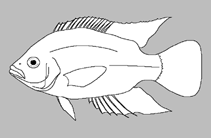Sarotherodon lamprechti Neumann, Stiassny & Schliewen, 2011
Uploaden van uw Foto's en video's
Google afbeeldingNo image available for this species;
drawing shows typical species in Cichlidae.
Google afbeeldingNo image available for this species;
drawing shows typical species in Cichlidae.
Classificatie / Names Lokale namen | Synoniemen | Catalog of Fishes(Genus, Soort(en)) | ITIS | CoL | WoRMS | Cloffa
> Cichliformes (Cichlids, convict blennies) > Cichlidae (Cichlids) > Pseudocrenilabrinae
Etymology: Sarotherodon: Greek, saros, -ou = sawdust + Greek, ther = animal * Greek, odous = teeth (Ref. 45335); lamprechti: Named for Jürg Lamprecht (1941–2000), who worked for his PhD on haplotilapiine cichlids, and who supported UKS as a mentor, teacher and friend at the Max-Planck-Institut (Seewiesen), and DN as a teacher (Ref. 86429).
Eponymy: Jürg Lamprecht (1941–2000) was a Swiss fish behaviourist, researcher and teacher. [...] (Ref. 128868), visit book page.
Etymology: Sarotherodon: Greek, saros, -ou = sawdust + Greek, ther = animal * Greek, odous = teeth (Ref. 45335); lamprechti: Named for Jürg Lamprecht (1941–2000), who worked for his PhD on haplotilapiine cichlids, and who supported UKS as a mentor, teacher and friend at the Max-Planck-Institut (Seewiesen), and DN as a teacher (Ref. 86429).
Eponymy: Jürg Lamprecht (1941–2000) was a Swiss fish behaviourist, researcher and teacher. [...] (Ref. 128868), visit book page.
Environment: milieu / climate zone / depth range / distribution range Ecologie
; zoet water pelagisch. Tropical; 6°N - 5°N, 8°E - 9°E
Verspreiding Landen | FAO regio's | Ecosystemen | Voorkomen | Point map | Introducties | Faunafri
Africa: Lake Ejagham in Cameroon (Ref. 86429).
Grootte / Gewicht / Leeftijd
Korte beschrijving Determinatiesleutels | Morfologie | Morfometrie
Dorsale stekels (totaal) : 15 - 16; Dorsale zachte stralen (totaal) : 12 - 14; Anale stekels: 3; Anale zachte stralen: 10 - 12. Diagnosis: Sarotherodon lamprechti is distinguished from all congeners by a lack of scales over the pectoral-fin base (Ref. 86429). Further distinguished from its sympatric sibling species, S. knauerae, and other S. galilaeus populations, by a combination of a prognathous lower jaw and an elongate ventral keel on the lower pharyngeal jaw; it also differs from the sympatric S. knauerae in a lower gill raker number, 20–25 vs. 24–30; longer pelvic fins reaching to or beyond first anal fin-spine, vs. not reaching beyond anus; from S. knauerae and other S. galilaeus populations and subspecies by long pectorals reaching the last anal fin-spine, vs. ending either in front of or at first anal fin-spine; upper lip large and prominent, upper lip length 22.5–28.4% of head length vs. 19.1– 25.4% in S. knauerae, 19.3–23.6% in neighbouring riverine S. galilaeus, 18.9–24.2% in S. g. borkuanus and 6.9–12.3% in S. g. multifasciatus; it differs from S. g. sanagaensis in lower preorbital depth, 16.3–25.2% of standard length vs. 25.0–27.8%; and from S. g. boulengeri in lower body depth, 36.3–40.4% of standard length vs. 44.5–50.0% (Ref. 86429). Finally it differs from phenotypically similar S. caroli and S. linnellii in lower gill raker number, 20–25 vs. 18–20 and 15–18; and from other Barombi Mbo Sarotherodon in higher number of dorsal fin-rays, 13–15 vs. 10–12 (Ref. 86429).
A pelagic phytoplanctivore found in Lake Ejagham; common in large swarms in open water, or on the lake bottom in deeper zones during the main breeding season (Ref. 86429). Nuptial males excavate shallow pits with narrow rims over sand, which serve as courtship territories and spawning sites; bower diameter ranges from 16-47 cm; larger bowers appear to be more common in deeper sandy areas, 3-9 m deep, where the majority of bowers are concentrated often in close proximity; neighbouring males often engage in agonistic interactions between bowers; only rarely, and only in shallow water less than 3 m deep, males in full nuptial colouration can be observed without bowers, but over natural depressions above fallen trees or flat stones (Ref. 86429). This species is a female mouth-brooder (Ref. 86429).
pelagic phytoplanctivore found in open water or on lake bottom in deeper zones; nuptial males excavate shallow pits with narrow rims over sand which serve as courtship territories and spawning sites; neighbouring males often engage in agonistic interactions between bowers; female mouth-brooder; reproduction takes place in the rainy season (August/September) (Ref. 86429).
Levenscyclus en paargedrag Maturiteit | Voortplanting | Paaien | Eieren | Fecunditeit | Larven
Nuptial males excavate shallow pits with narrow rims over sand, which serve as courtship territories and spawning sites; bower diameter ranges from 16-47 cm; larger bowers appear to be more common in deeper sandy areas, 3-9 m deep, where the majority of bowers are concentrated often in close proximity; neighbouring males often engage in agonistic interactions between bowers; only rarely, and only in shallow water less than 3 m deep, males in full nuptial colouration can be observed without bowers, but over natural depressions above fallen trees or flat stones (Ref. 86429). This species is a female mouth-brooder (Ref. 86429).
Hoofdreferentie
Upload your references | Referenties | Coördinator : Kullander, Sven O. | Medewerkers
Neumann, D., M.L.J. Stiassny and U.K. Schliewen, 2011. Two new sympatric Sarotherodon species (Pisces: Cichlidae) endemic to Lake Ejagham, Cameroon, west-central Africa, with comments on the Sarotherodon galilaeus species complex. Zootaxa 2765:1-20 (Ref. 86429)
Status op de Rode Lijst van het IUCN (Ref. 130435: Version 2024-2)
Ernstig bedreigd (CR) (B1ab(iii)+2ab(iii)); Date assessed: 15 October 2014
CITES
Not Evaluated
Gevaar voor de mens
Harmless
Gebruik door de mens
FAO - Publication: search | FishSource |
Meer informatie
Trophic ecology
Voedselitems
Dieetsamenstelling
Voedselconsumptie
Food rations
Predatoren
Voedselitems
Dieetsamenstelling
Voedselconsumptie
Food rations
Predatoren
Population dynamics
Groeiparameters
Max. ages / sizes
Length-weight rel.
Length-length rel.
Lengtefrequenties
Massaconversie
Rekrutering
Abundantie
Groeiparameters
Max. ages / sizes
Length-weight rel.
Length-length rel.
Lengtefrequenties
Massaconversie
Rekrutering
Abundantie
Life cycle
Voortplanting
Maturiteit
Maturity/Gills rel.
Fecunditeit
Paaien
Spawning aggregations
Eieren
Ontwikkeling van de eieren
Larven
Larvale populatiedynamiek
Voortplanting
Maturiteit
Maturity/Gills rel.
Fecunditeit
Paaien
Spawning aggregations
Eieren
Ontwikkeling van de eieren
Larven
Larvale populatiedynamiek
Anatomy
Kieuwoppervlak
Brain
Otolith
Kieuwoppervlak
Brain
Otolith
Physiology
Body composition
Nutrients
Zuurstofverbruik
Zwemtype
Zwemsnelheid
Visual pigments
Fish sound
Diseases & Parasites
Toxicity (LC50s)
Body composition
Nutrients
Zuurstofverbruik
Zwemtype
Zwemsnelheid
Visual pigments
Fish sound
Diseases & Parasites
Toxicity (LC50s)
Genetics
Genetica
Heterozygosity
Erfelijkheid
Genetica
Heterozygosity
Erfelijkheid
Human related
Aquaculture systems
Aquacultuurprofielen
Kweeklijnen
Ciguatera cases
Stamps, coins, misc.
Aquaculture systems
Aquacultuurprofielen
Kweeklijnen
Ciguatera cases
Stamps, coins, misc.
Tools
E-boek | Veldgids | Lengtefrequentie Tool | Levenscyclus tool | Verspreidingskaart | Classification Tree
| Catch-MSY |
Speciale rapporten
Bekijk gegevens voor het houden in een aquarium | Bekijk Fact Sheets voor de soort | Bekijk Aquacultuur Fact Sheets
Download XML
Internetbronnen
AFORO (otoliths) | Aquatic Commons | BHL | Cloffa | BOLDSystems | Websites from users | Bekijk FishWatcher | CISTI | Catalog of Fishes: Genus, Soort(en) | DiscoverLife | ECOTOX | FAO - Publication: search | Faunafri | Fishipedia | Fishtrace | GenBank: genoom, nucleotide | GloBI | Google Books | Google Scholar | Google | IGFA World Record | MitoFish | Otolith Atlas of Taiwan Fishes | PubMed | Reef Life Survey | Socotra Atlas | Tree of Life | Wikipedia: ga naar, zoek | World Records Freshwater Fishing | Zoobank | Zoological Record
Estimates based on models
Fylogenetische diversiteitsindex (Ref. 82804): PD50 = 0.5001 [Uniqueness, from 0.5 = low to 2.0 = high].
Bayesian length-weight: a=0.01862 (0.00830 - 0.04177), b=3.01 (2.82 - 3.20), in cm total length, based on LWR estimates for this (Sub)family-body shape (Ref. 93245).
Trofisch niveau (Ref. 69278): 2.4 ±0.2 se; based on size and trophs of closest relatives
Fishing Vulnerability (Ref. 59153): Low vulnerability (10 of 100).




